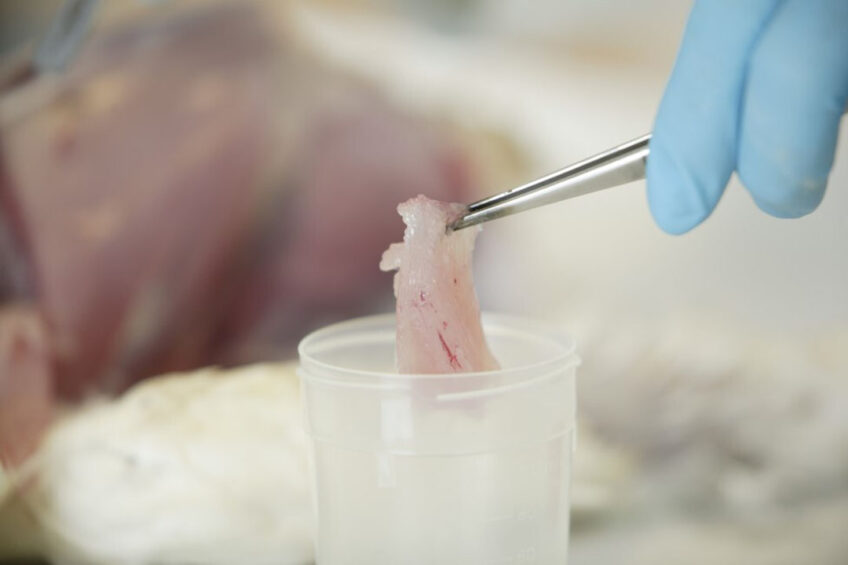Poultry meat consumption has dramatically increased over the last few decades and will continue to do so. But it is not just about quantity, consumers are more attentive to meat quality, too. Besides this, poultry meat is more perishable than meat from other livestock, such as beef or pork. Therefore, measuring freshness is essential for meat quality assurance in poultry processing plants.
According to modern consumers ‘all natural’ is an important attribute when purchasing poultry meat. Several qualitative meat studies have shown that freshness, sensory factors, perceived healthfulness, meat colour, appearance, physical form and fat content are major factors contributing to product choice. In addition, customers prefer to buy raw rather than cooked poultry meat as this enables them to assess the meat quality better.
The biggest issue for fresh and appealing flavour is oxidative rancidity or lipid oxidation, which causes unpleasant odours and flavours. To delay oxidation, fat content, ingredient interactions and storage conditions must be monitored.
Spoilage indicators
Meat spoilage is a complex process associated with various types of bacterial activity which, in combination with external conditions, are responsible for the oxidation of glucose, lactic acid, fatty acid and protein degradation. Some chemical compounds, such as alcohols, hydrogen sulphide, acetate, methyl ethyl ketone and dimethyl sulphide, are considered as spoilage indicators.
During the spoilage process, glucose and its direct metabolites are broken down by enzymes and bacteria, then the catabolism of proteins starts which produces amines and thiols, producing unpleasant odours, discoloration and deteriorated integrity of muscle fibres. Since these by-products are toxic, consumption of the meat at this stage could be a severe hazard.
Traditional freshness detection approaches
Traditional methods used to evaluate meat freshness include sensory evaluations, chemical measurements and microbiological measurements. In sensory evaluation the human senses are used to provide information on colour, odour, meat texture and overall meat quality. However, there is the high cost of the expert team and judgment deviations occur due to subjectivity.
Chemical measurement is a precise and objective method based on measurements of meat pH and total volatile base nitrogen; however, this method is time-consuming. Microbiological measurement is also time-consuming, destructive and inefficient.
Modern freshness detection approaches
To assess meat quality and safety it is necessary to design efficient, cost-effective and non-destructive techniques to analyse meat freshness. Modern approaches include the electronic nose, electronic tongue, computer vision system, artificial tactile system, ultra-fast gas chromatography, torrymeter, colorimetric sensor array and hyperspectral imaging techniques.
Electronic nose
The electronic nose is a device comprising an array of chemical sensors sensitive to a particular odourant, coupled with data processing and pattern recognition algorithms capable of recognizing simple or complex odours to evaluate raw meat. Using an electronic nose, the entire aroma profile of a meat sample can be analyzed and compared with aroma profiles stored in a database using pattern recognition algorithms.
Electronic tongue
The electronic tongue is formed by a set of six electrodes, signal conditioning system, data acquisition system and tools for multivariate data analysis. The electrodes are made of various materials including gold, silver, copper, lead, zinc and graphite. The sensors in this device are integrated in an array and their response is analyzed using suitable pattern recognition algorithms.
Computer vision system
A computer vision system is used to measure colour-related freshness parameters. In this system, a high-resolution camera takes images of the poultry meat and colour information is extracted as a feature variable for samples using an image processing method. In the next step, the captured images are pre-processed and analyzed using MATLAB software.
Artificial tactile system
An artificial tactile system can be used to measure elasticity-related parameters in meat samples. The extracted information yields the feature variables for samples. In this system an indenter connected to a pressure sensor is used to mimic the process of using a human hand to touch meat to ‘sense’ the texture or physical integrity of the meat.
Ultra-fast gas chromatography
Ultra-fast gas chromatography is an analytical technique used for rapid data acquisition and analysis of meat samples to trace volatile and semi-volatile compounds. This method can simultaneously separate and identify chemical compounds. However, this technique is relatively expensive and its use requires specialist knowledge.
Torrymeter
A torrymeter can be used to determine meat freshness by measuring modifications in the electrical properties of tissues. Changes in the dielectric properties of muscles are closely related to meat spoilage. A torrymeter is an objective, efficient and accurate device that is easy to use and non-destructive. The sensors in this device emit a small current which passes through the meat and calculates a voltage. The phase angle between the current and the voltage is measured and then converted to a simple scale ranging from 0 (least fresh) to 18 (most fresh).
Colorimetric sensor array
Colorimetric sensor arrays are capable of changing colour further to a reaction with volatile compounds produced in packaged meat. This method offers a simple, practical, instrument-free way to evaluate meat freshness directly with the naked eye.
Hyperspectral imaging technique
The hyperspectral imaging system integrates both spectroscopy and imaging techniques to identify different compounds and their distribution in meat samples to provide an objective evaluation of meat quality. This method effectively quantifies and identifies quality attributes of meat, such as colour, quality grade, marbling, maturity and texture.
Comprehensive approach
Modern freshness detection methods can only be used to detect and provide information on certain aspects of meat freshness, they cannot carry out a comprehensive assessment of meat freshness or spoilage. It is, therefore, essential to obtain meat freshness information from different perspectives to be able to fully and accurately evaluate meat samples.
Source: Modern approaches to evaluate poultry meat freshness – Poultry World













